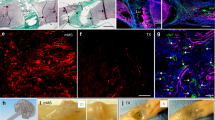Summary
A report is given of successful healing of artificially produced intramedullary wound surfaces and outgrowth of nerve fibres in the experimental dog by simple application of the basic physiological principles valid in wound repair in general, namely to bring such surfaces into long-lasting, close and tensionless contact. This contact was established by utilization of the biomechanical phenomenon that on extension of the spine the spinal cord slackens and its tissue is telescoped. Such contact suppressed practically all adverse reactions of the medullary tissue, namely, formation of an intramedullary pial-glial scar, intramedullary cysts and autotomy of the spinal cord. As a result a biological reconstruction of the injured spinal cord could be realized and the validity of the principles of functional neurosurgery put forward a couple of years ago by our biomechanical school [4] could be corroborated.
Résumé
Un rapport est présenté concernant le traitement et la guérison de surfaces intramédullaires endommagées de façon artificielle, ainsi que la croissance de fibres nerveuses dans le cas de chiens d'expérimentation, et ce sur la base des théories physiologiques de base mises en pratique pour le traitement des blessures en général, et qui consiste á faire entrer en contact étroit et prolongé ces surfaces. Cette mise en contact a pu être réalisée grâce au phénomène biomécanique qui veut que la colonne vertébrale mise en extension fasse raccourcir la moelle épinière en télescopant son tissu. La mise en contact décrite ci-dessus a permis de supprimer quasiment toutes les réactions néfastes du tissu médullaire, c'est-à-dire la formation d'une cicatrice intramédullaire pio-gliale, de kystes intramédullaires, et de l'autodestruction de la moelle épinière. Grâce à ces résultats, une reconstruction biologique de la moelle épinière endommagée a pu être observée et le bien-fondé des théories de neurochirurgie fonctionnelle, mises en avant par notre Ecole biomécanique il y a quelques années [4], a pu être confirmé.
Similar content being viewed by others
References
Bernstein JJ, Bernstein ME, Wells MR (1978) Spinal cord regeneration and axonal sprouting in mammals. In: Waxman, SG (ed) Physiology and pathology of axons. Raven Press, New York
Braford M (1980) Axoplasmic transport in injured spinal cords. Transactions of First International Symposium on Spinal Cord Reconstruction held January 7–10, 1980, in Las Vegas, Nevada, under the auspices of Georgetown University and Help Them Walk Again Foundation
Breig A (1960) Biomechanics of the central nervous system. Almqvist & Wiksell, Stockholm
Breig A (1978) Adverse mechanical tension in the central nervous system. An analysis of cause and effect. Relief by functional neurosurgery. Almqvist & Wiksell International, Stockholm, John Wiley & Sons, New York London Sydney Toronto
Brinker WO, Flo GL (1975) Principles and application of external skeletal fixation. In: Rudy RL (ed) Symposium on management of limb fractures in small animals. The veterinary clinics of North America. WB Saunders, Philadelphia London Toronto
Britten S (1977) Animal research: whose responsibility? World Med J 24:51–53
Bucy PC (1978) Immediate immobilization of fractured spines. Editorial. Surg Neurol 10:63
Ducker TB, Saleman M, Daniell HB (1978) Experimental spinal trauma, III: therapeutic effect of immobilization and pharmacologie agents. Surg Neurol 10:71–76
Forssberg H, Grillner S (1980) Spinal control of locomotion. Transactions of First International Symposium on Spinal Cord Reconstruction held January 7–10, 1980, in Las Vegas, Nevada, under the auspices of Georgetown University and Help Them Walk Again Foundation
Goldberger H, Murray M (1974) Restitution of function and collateral sprouting in cat spinal cord: the deafferented animal. J Comp Neurol 158:37–54
Greenberg J, McKeerer PE, Balentine JD (1978) Lysosomal activity in experimental spinal cord trauma: an ultrastructural cytochemical evaluation. Surg Neurol 9:361–364
Guth L, Albuquerque EX, Deshpande SS, Barrett CP, Donati EJ, Warnick JE (1980) Ineffectiveness of enzyme therapy on regeneration in the transected spinal cord of the rat. J Neurosurg 52:73–86
Kakulas BA (1980) Personal communication. (From Department of Neuropathology, Royal Perth Hospital, Perth, Western Australia)
Kao CC (1974) Comparison of healing process in transected spinal cords grafted with autogenous brain tissue, sciatic nerve, and nodose ganglion. Exp Neurol 44:424–439
Kao CC (1980) Axonal reaction to transection, Transactions of First International Symposium on Spinal Cord Reconstruction held January 7–10, 1980, in Las Vegas, under the auspices of Georgetown University and Help Them Walk Again Foundation
Kao CC, Chang LW (1977) The mechanism of spinal cord cavitation following spinal cord transection. Part I: A correlated histochemical study. J Neurosurg 46:197–209
Kao CC, Shimizu Y, Perkins LC, Freeman LW (1970) Experimental use of cultured cerebellar cortical tissue to inhibit the collagenous scar following spinal cord transection. J Neurosurg 33:127–139
Liu CN, Chambers WW (1958) Intraspinal sprouting of dorsal root axons. Development of new collaterals and preterminals following partial denervation of the spinal cord in the cat. Arch Neurol Psychiatr 79:46–61
Murray M, Goldberger ME (1974) Restitution of function and collateral sprouting in the cat spinal cord: The partially hemisected animal. J Comp Neurol 1958:19–36
Ramńn y Cajal S (1928) Degeneration and regeneration of the nervous system. Translated and edited by RM May, Vol II
Remfry J (1977) The human approach to experimental animals. World Med J 24:54
Renard C (1980) Approche expérimental du traitement des lésions médullaires traumatiques par immobilisation rachidienne totale. Thèse de Medicine Nancy 1980
Scott WN (1977) Animal research. Editorial. World Med J 24:49
Tunturi AR (1978) Elasticity of the spinal cord, pia and denticulate ligament in the dog. J Neurosurg 48:975–979
Windle WF (1980) Recollections of research in spinal cord regeneration. Transactions of First International Symposium on Spinal Cord Reconstruction held January 7–10, 1980, in Las Vegas, Nevada, under the auspices of Georgetown University and Help Them Walk Again Foundation
Author information
Authors and Affiliations
Rights and permissions
About this article
Cite this article
Breig, A., Renard, M., Stefanko, S. et al. Healing of the severed spinal cord by biomechanical relaxation and surgical immobilization. Anat. Clin 4, 167–181 (1982). https://doi.org/10.1007/BF01798886
Issue Date:
DOI: https://doi.org/10.1007/BF01798886




